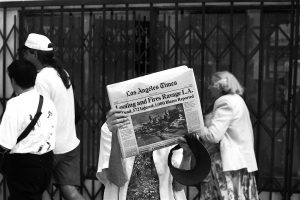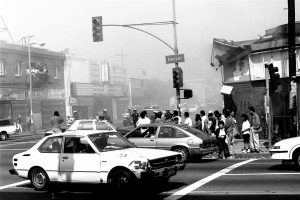“No justice, no peace!” was the anthem of the day in late April 1992 in Los Angeles as local blacks, Latinos/as, and even a sprinkling of Asian Americans and whites joined in the five day “rebellion” that purportedly underscored the injustice of the verdict in the Rodney King police brutality trial. It ended with a devastating toll of losses—54 deaths, more than 2,300 injuries, 3,600 fires, 1,100 buildings destroyed, 4,500 businesses looted, more than 12,000 arrested, and $1 billion in damage. But for the many who joined in the events of those days, and for the thousands who stayed at home but understood all too well why others had gone, Rodney King was not the symbol of injustice that was being protested; a black girl, Latasha Harlins, was.

“Looting and Fires Ravage LA,” reads the front page of the Los Angeles Times on May 1, 1992. Dark Sevier/via Flickr CC-BY-NC 2.0
Immortalized in rap, song, theatre, protest, film, and blogs, and increasingly invoked as one of the iconic examples of injustice toward black women that has led to the #SayHerName movement, Latasha Harlins’s murder and its contested treatment in the Los Angeles courts led to much of the destruction caused by the 1992 Los Angeles riot/insurrection. Rodney King certainly fit the bill as the “classic” black male victim of white male police abuse often associated with the outbreak of a race riot. Moreover, the rebellion would not have been possible if not for years of simmering angst driven by structural inequalities that had long afflicted black South Central communities in the city. The memory, however, of Latasha Harlins, an African American girl killed by a Korean-born naturalized citizen, a woman, lit many of those fires and kept them going. More than one-half of the approximately 3,100 businesses operated by Koreans and Korean Americans in Los Angeles were burned, looted, or vandalized at an approximate total loss of $347 million dollars during the LA uprising—much because of Latasha’s death in one of those stores a year earlier.
On March 16, 1991, 13 days after the Rodney King videotaped assault by the LAPD, Latasha Harlins walked into the Empire Liquor Market in South Central Los Angeles to buy orange juice. Within five minutes, the 15-year-old lay in front of the counter, dying from a single, close range gunshot wound to the back of her head delivered by the storekeeper’s wife—Soon Ja Du. She had two dollars in her hand meant to pay for the $1.79 bottle of juice that Du had accused her of stealing. The Harlins murder also was videotaped—not by an anxious onlooker, but by the store’s anti-theft video camera. That film too went “viral” on news channels, and not only in Los Angeles. The story picked up national traction because of the growing antagonism between black Americans and Koreans/Korean Americans, particularly shopkeepers, in urban centers around the country—New York, Chicago, San Francisco, and Washington, DC, among others. Eight months later, the videotape resurfaced on television after the controversial sentencing of Du, who was convicted of voluntary manslaughter, but not sentenced to any jail time by Judge Joyce Karlin. It was not just that Karlin gave a disturbingly light punishment to Du; the judge also implicated Harlins as the aggressor in her sentencing statement, suggesting that the deceased black teen was the actual criminal and that Du was her victim.

A scene from the streets of Los Angeles, May 1, 1992. Dark Sevier/via Flickr CC-BY-NC 2.0
Many Angelenos, incensed by what was one of the most lenient sentences for voluntary manslaughter with the use of a gun handed down in California that year, refused to let the issue die. The Latasha Harlins Justice Committee held weekly protests outside the Compton court where Karlin worked and sponsored a recall petition drive. Black churches and local civil rights organizations became heavily involved in civil disobedience efforts. The district attorney appealed the sentence. The California Court of Appeals, however, stood by Karlin’s sentence, citing judicial discretion as its principal reasoning. The appeals court handed down its decision just six days before the Simi Valley verdict in the Rodney King police trial, which acquitted all four police officers accused of using excessive force. Not only did Harlins’s case remain singularly in the public eye as a galling act of judicial injustice, its timing meant that it was inextricably yoked with the Rodney King beating and subsequent not-guilty Simi Valley trial finding. Media outlets repeatedly played the two videotaped events consecutively during the uprising. They both seemed to prove that there was, indeed, “no justice” in the criminal justice system for African Americans, male or female.
Race riots in the United States in which African Americans have been victims and actors have often had female-driven catalysts or elements of female victimization that have escalated the unrest. In 1863, black men in Detroit joined the fray when marauding white crowds tried to burn down buildings where women and children were housed. The Houston Race Riot of 1917 ensued in part after the local police, searching for an alleged gambler, cursed, beat, and dragged his black female associate into the street in her underclothes, and then decided to send her to the local prison farm for 90 days because she was “biggety.” The next year, a brick thrown through the front window of an African American woman’s home by white segregationists began a riot in Philadelphia. Likewise, African American onlookers in 1966 rebelled in Roxbury when Boston police began to beat and threaten women and children involved in a “sit in” at the local Department of Welfare. In at least four “race riots” that occurred in Los Angeles—the Chinese massacre of 1871, the Zoot Suit Riots of 1943, the Watts Riot of 1965, and the LA Rebellion of 1992—victimized women of color became catalysts for these racial conflagrations. What all of these events, not just the 1992 “riot,” teach us is that black women brutalized, or left unprotected, by the criminal justice system have been, and will continue to be, reasons people take to the streets to demand equal protection under the law. Black female lives, like that of Latasha Harlins’s, matter.
This post first appeared on AHA Today.
Brenda Stevenson is the Nickoll Family Endowed Professor of History and professor of African American studies at the University of California, Los Angeles.
Tags: AHA Today Current Events in Historical Context African American History Social History Urban History
Comment
Please read our commenting and letters policy before submitting.






